Using chat in Jira Service Management
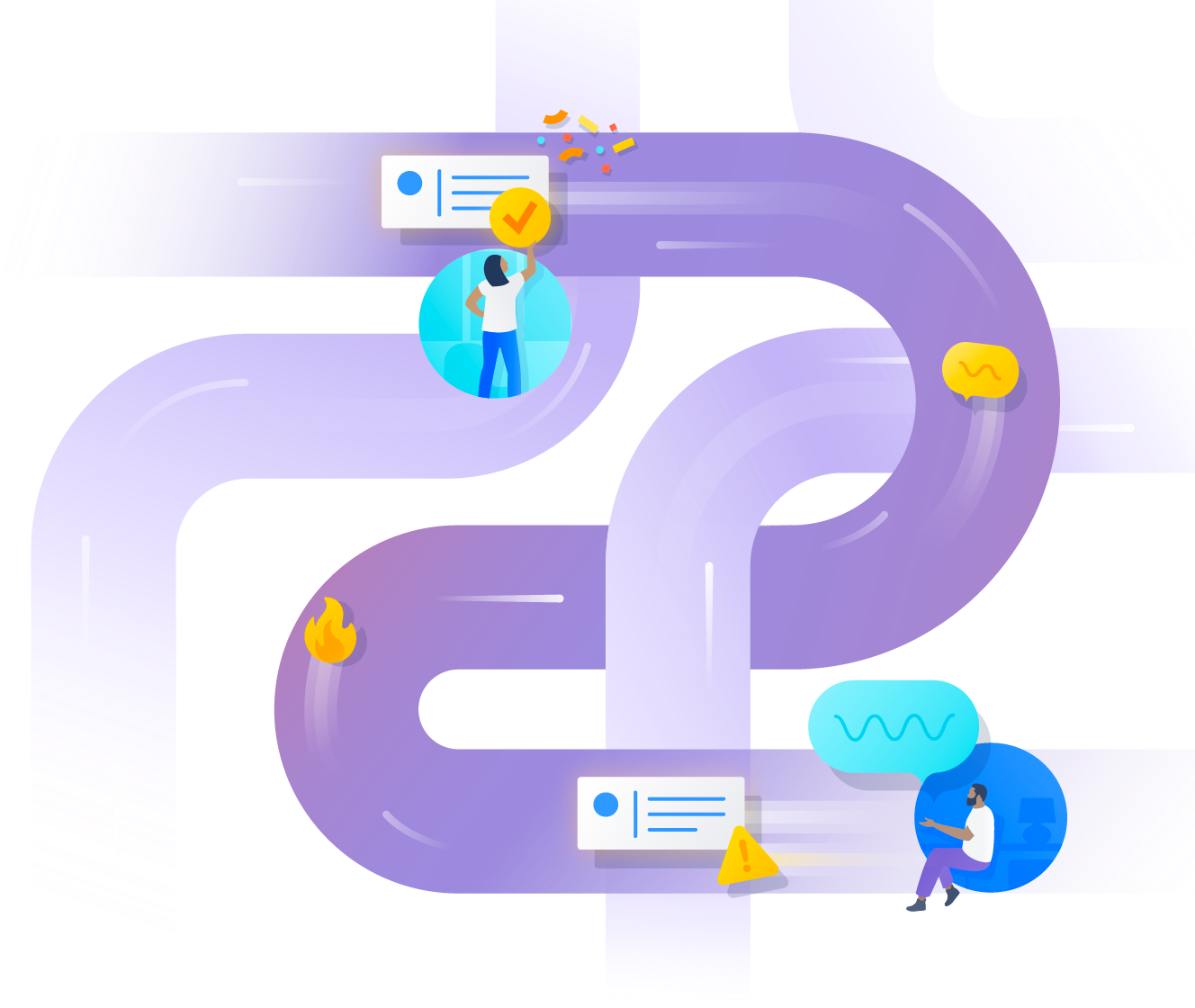
Overview
Whether you work in an office, remotely, or a combination of the two, it’s hard to imagine getting much done without chat tools like Slack, Microsoft Teams, or Zoom. These tools aren’t just for conversations — it’s where coworkers connect, get and give help, swarm on issues, and solve problems. Connecting these tools to Jira Service Management allows for smooth communication, letting your team track resolution progress, work on incidents, and update stakeholders, all within their conversations.
Teams of all types, like IT, Dev, operations, marketing, legal, and more, have discovered that integrating their chat tools with Jira Service Management helps them reduce context-switching and the amount of reporting needed. By connecting your service projects with Slack, Teams, or Zoom, your team will be more productive, resolving issues and outages faster for your customers.
Read on to learn how to connect your service project to your chat tool, and discover how you can capture, manage, and resolve issues and incidents directly in your conversations.
Atlassian Assist is Jira Service Management’s conversational request management chat extension that facilitates real-time responses to incoming questions and requests from your chat tool and provides an automated two-way sync with Jira Service Management.
Use chat and Atlassian Assist to create and manage requests directly from Slack or Microsoft Teams.
- Give and get help where you already are
- Work requests from start to finish, all in the same conversation
- Automatically recognize requests and reply with the virtual agent, a premium feature (Slack only)
Get Jira Service Management’s request management Slack or Microsoft Teams app.
ChatOps is Jira Service Management’s alert and incident management chat functionality that enables responder teams to stay notified of alerts, quickly swarm and collaborate on incidents, track important information, and take actions directly from chat applications.
For end-to-end alert and incident management within Slack and Microsoft Teams.
- Get alert and incident notifications
- Create channels and meetings to collaboratively resolve incidents
- Respond to alerts and incidents using buttons and commands from channels
Get Jira Service Management’s incident management Slack, Microsoft Teams, or Zoom apps.
Watch our Jira Service Management Microsoft Teams and Slack Integrations
Integrating chat tools with Jira Service Management offers several benefits, enhancing team productivity, communication, and incident management. Enhance your team’s efficiency and effectiveness in team collaboration, incident management, and customer service.
Conversational ticketing 101
What is conversational ticketing?
Conversational ticketing is support that happens in real-time between agents in Jira Service Management and help-seekers on a chat platform like Slack or Microsoft Teams. With bi-directional sync between your service desk and chat messages, you can work requests from start to finish without ever leaving your conversations.
Why do you need it?
In an age defined by hybrid-remote work, Slack and Microsoft Teams have emerged as key ways to keep teams connected and move work forward. With so much communication happening in these tools, it’s only natural that when help-seekers have a question, they look for ways to get their answer without ever leaving their chat conversations. Without conversational ticketing, support teams face the challenge of tracking down hundreds of requests scattered across DMs and channels and funneling them back into their process. The frequent context-switching and added manual steps can take their toll on productivity, resolution times, and more.


How can you use it?
Conversational ticketing allows agents to meet help-seekers wherever they work, without disrupting their own ways of working. If you’ve ever found yourself redirecting people to your service desk portal in a Slack channel, or transcribing Microsoft Teams direct messages (DMs) into an issue summary on an employee's behalf, you could have benefitted from the seamlessness of conversational ticketing. In addition to catering to classic IT service desk workflows, chat also supports a variety of business teams, such as: HR teams can field onboarding and benefits questions; SalesOps teams can manage their deal desk and CRM updates; Legal teams can capture contract review asks; and more.
Why will you love it?
It’s fast, human, and easy. It not only makes getting support feel less like a hassle for help-seekers, but it makes work trackable and visible for agents fielding requests across multiple DMs, emails, channels, and portals. With the ability to capture and work requests from your chat tool, you can increase team productivity, make work visible, and improve customer satisfaction.
Last but not least, the most important question…
How can you try it in Jira Service Management?
In Jira Service Management, we offer a chat feature that allows you to connect to our conversational help bot, Atlassian Assist, to your service project. Bi-directional sync between your conversations and your service desk enable a seamless service experience regardless of how or where you and your customers prefer to work. This chat functionality can be set up and managed through channels or project settings, and getting up and running only takes a few minutes.
Getting started with chat
Jira Service Management’s chat feature is built for simplicity and flexibility, with a lightweight onboarding process to match. Before you get started, there are three key elements that are critical to your conversational ticketing workflows:
- Agent channel/team
- Request channel
- Atlassian Assist
Agent channel/team
A private channel or team within your Slack or Microsoft Teams workspace, respectively, where agents can assign, edit, and respond to requests. You can work your entire queue directly from here without ever leaving your chat tool.
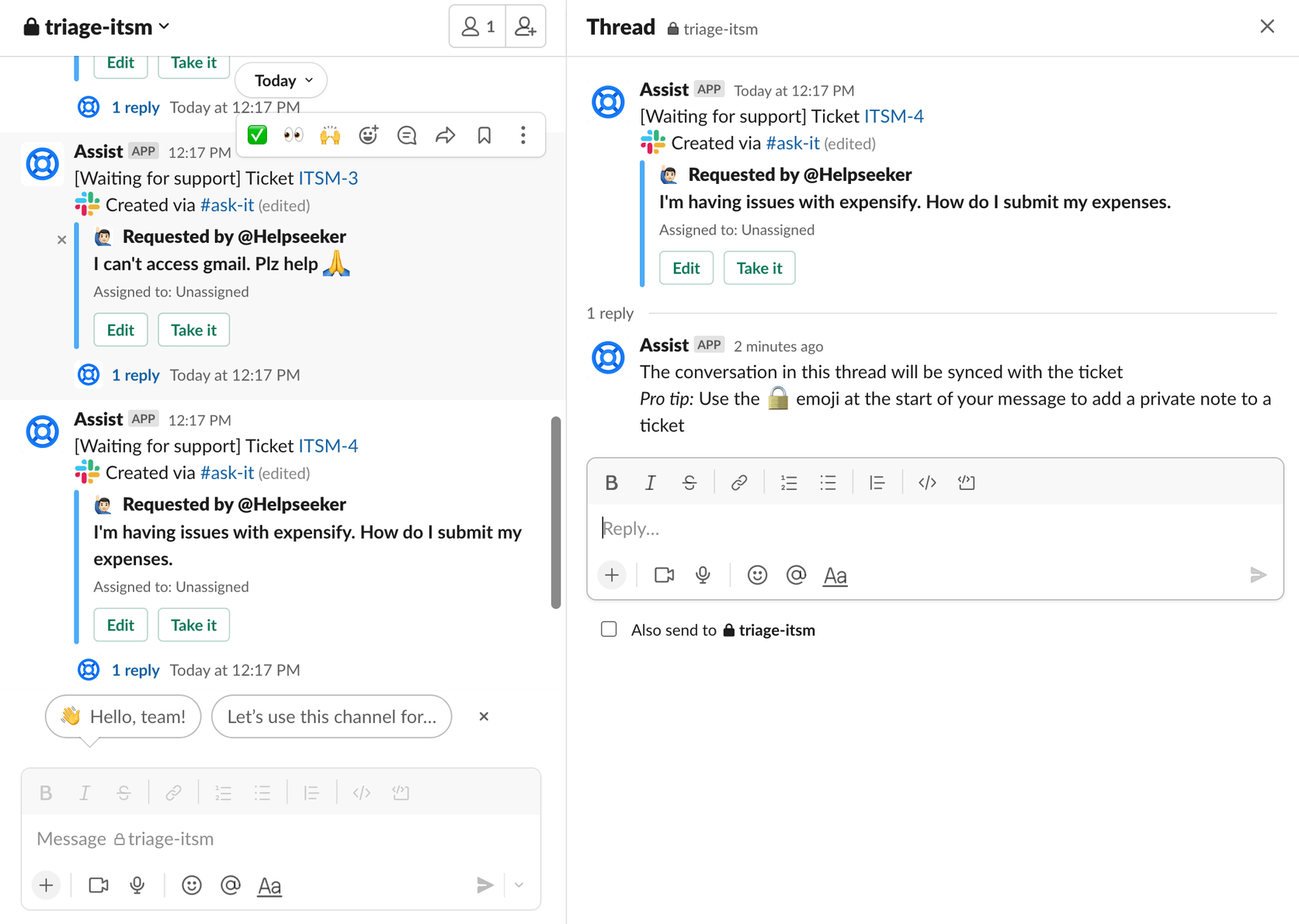
Request channel
A Slack or Microsoft Teams channel where help-seekers can make requests. When someone posts a message in a request channel, you can turn it into a ticket using emojis or message actions. Quickly create an issue by reacting with a ticket emoji or selecting More actions. This prompts the request to appear in the agent channel for the associated service project’s queue.
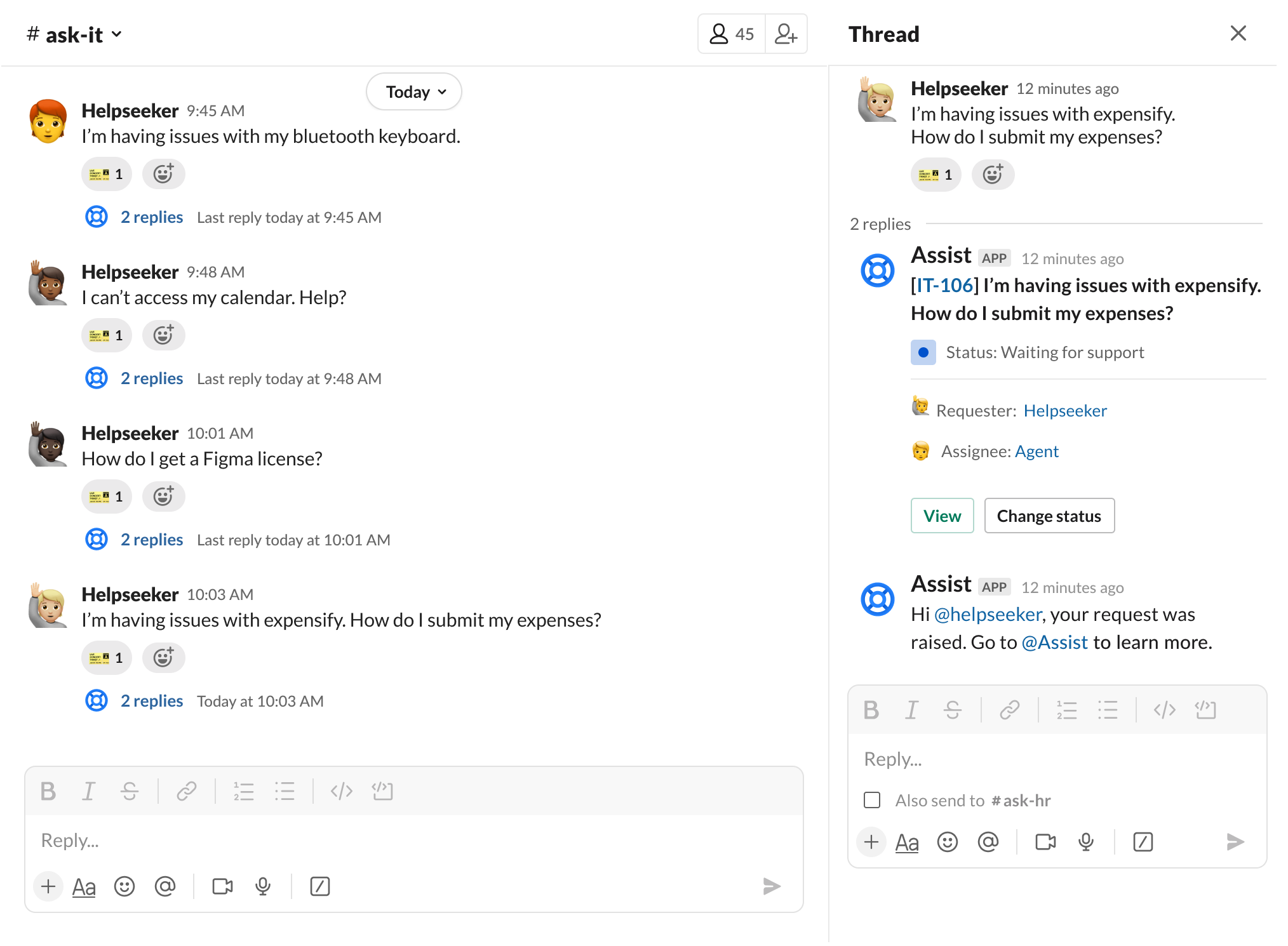
Atlassian Assist
Assist is the name for the Slack and Microsoft Teams app that powers our conversational support capabilities. The Assist bot not only allows you to connect service projects to your chat tool, but also enables a variety of actions directly within Slack and Teams to manage issues through to resolution.
Quickstart guide
To get started, Jira Service Management project admins can select Channels from the left-hand navigation, then Chat > Configure. (Note: you can also access the chat feature from your project settings.)
You’ll then follow the three quick steps below for your corresponding tool. Please note that the order of operations is slightly different depending on which tool you use.
If you're using Slack...
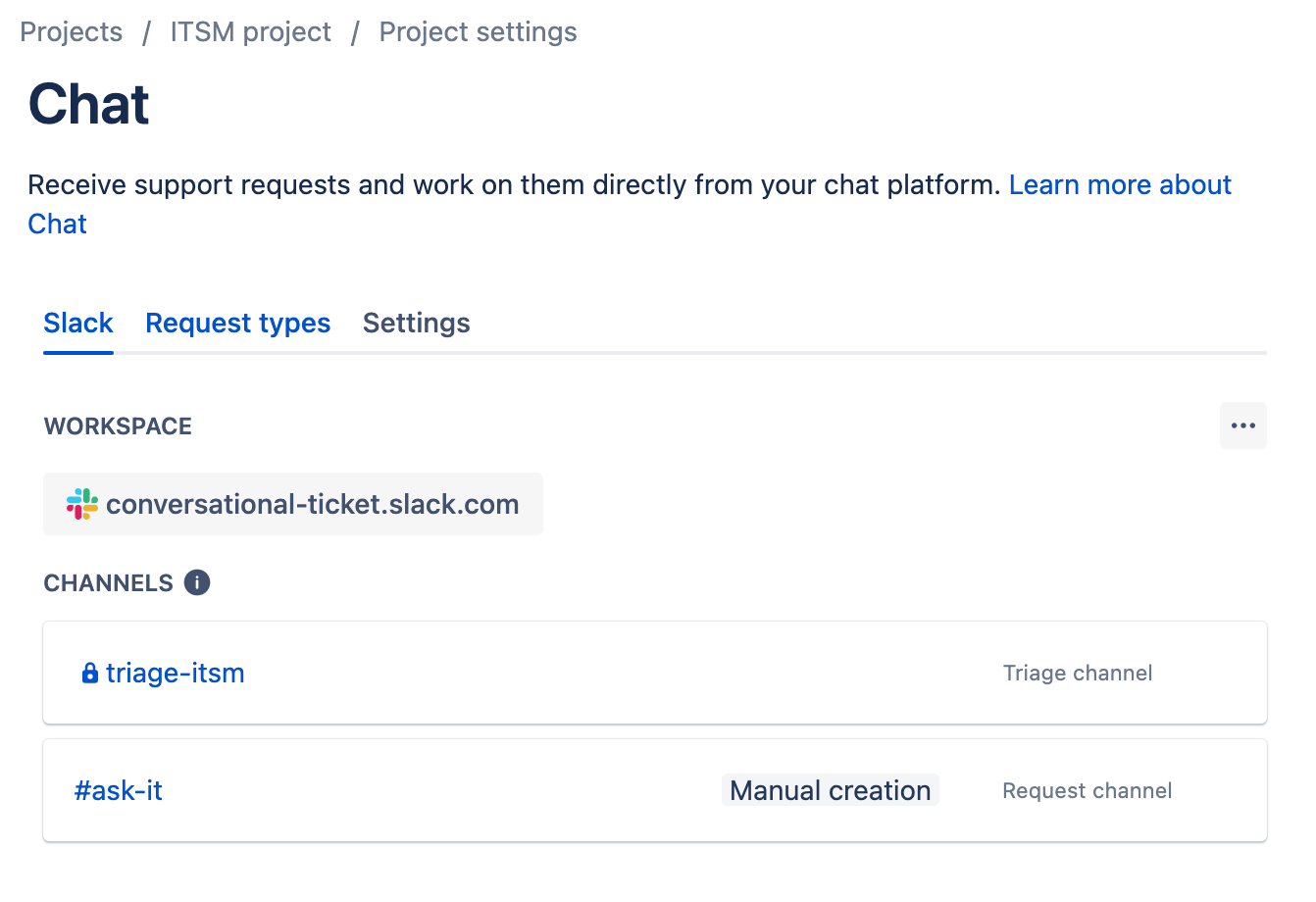
To set up chat in your service project:
1. From your service project sidebar, select Channels, then Chat, then Configure.
2. Select Add to Slack.
3. Select the Slack workspace you want to connect your Jira site to then select Allow.
Tip: If another service project on your Jira site is connected to Slack, you can’t select another workspace.
4. Select the request types you want to use in Slack, then select Add. You can add more later.
5. The last step creates a private agent channel for your team. Assist suggests a name based off your project key, but you can rename it if you want.
6. Select Create to finish setup.
If you're using Microsoft Teams..
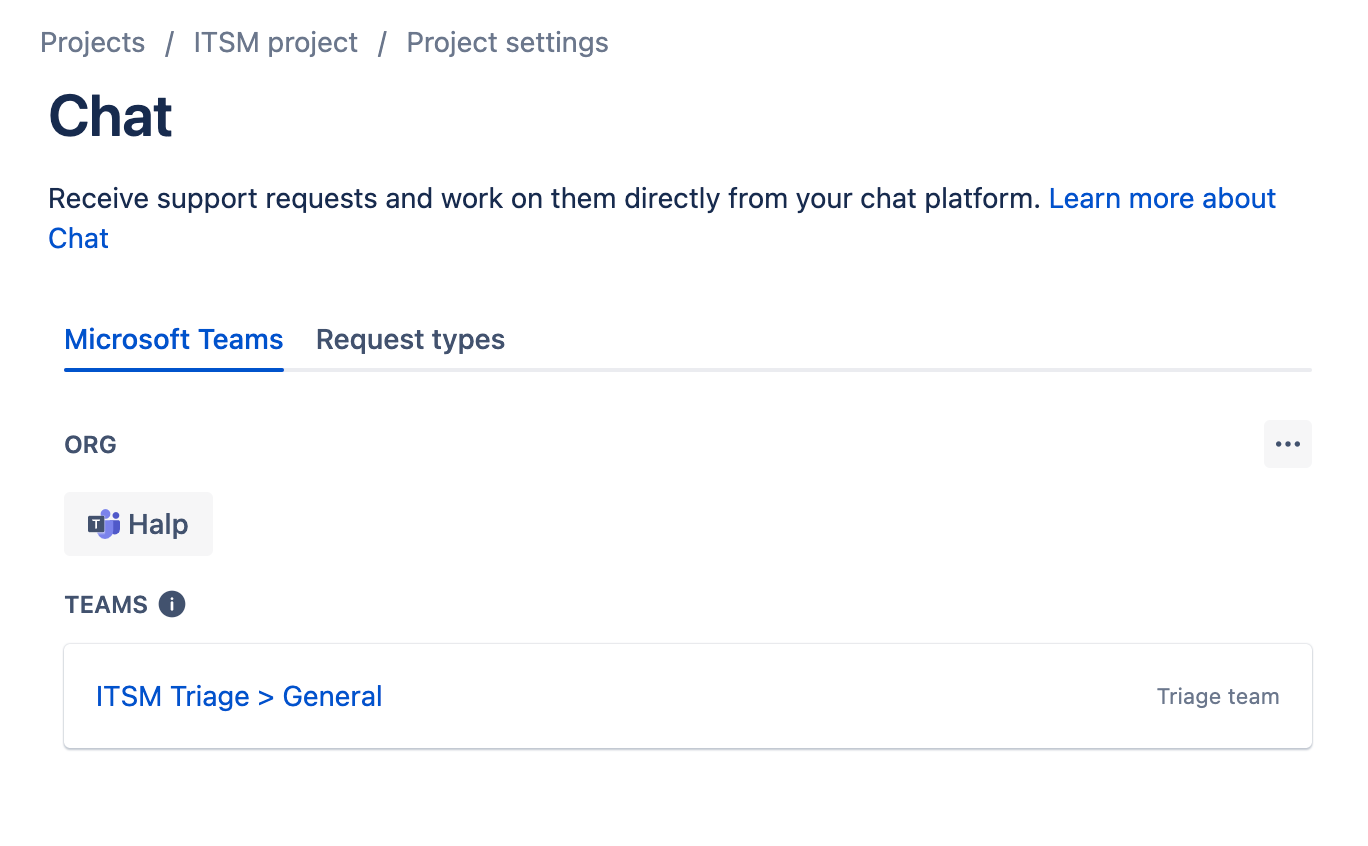
1. Set up your agent team. Before installing the Assist app, navigate to Microsoft Teams to create a designated private team for your agent channel and invite your agents.
2. Connect to Teams and choose request types. Navigate back to chat settings and follow the Assist installation prompts through the app store to connect to Teams and add the bot to your private agent team. From there you can sign in via the chat settings and select the request types you wish to use.
Tip: During the onboarding tour, you may need to grant the app permissions. If you’re unable to grant permissions, reach out to your Teams admin for assistance.
3. Set up your request channel. Create a new channel (or select an existing one) in Teams, and invite the Assist bot.
Tip: To add the Assist bot to a team, type “@get bots” in the channel and select Assist.
Helpful reminders
- A Jira site can only connect to one Slack workspace or Microsoft Teams org.
- Some request type fields, like URLs and attachments, are not supported by Slack or Teams. These request types cannot be used if the unsupported field is marked as required.
Creating and managing tickets with Atlassian Assist
App home or Teams tab
Whether you’re a Slack or Teams user, Jira Service Management offers a native in-app experience to manage your service desk.
Once you have the chat functionality up and running, there are a variety of simple ways to capture and interact with issues using the Assist app.
From a request channel
React to any message in a request channel with a ticket emoji (Slack) or use the ticket creation message action (Teams).
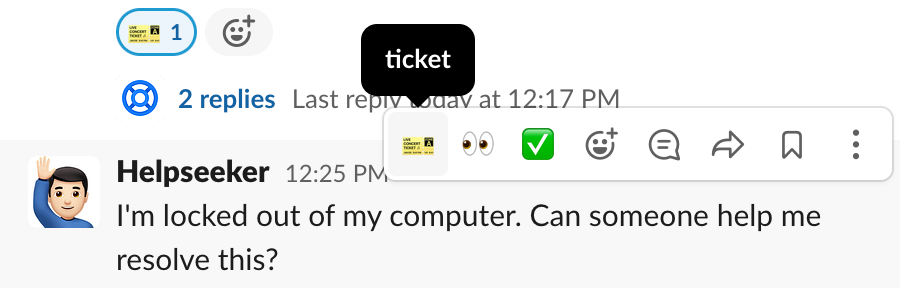

From a DM
Use message actions to raise a request with Assist. Once the request is raised, help seekers can add comments and follow progress directly from Assist app home.
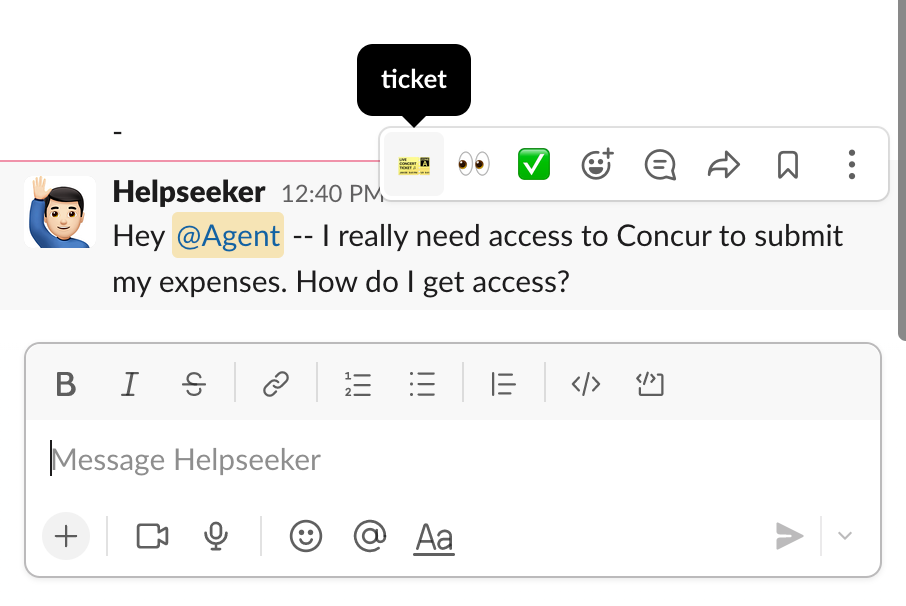
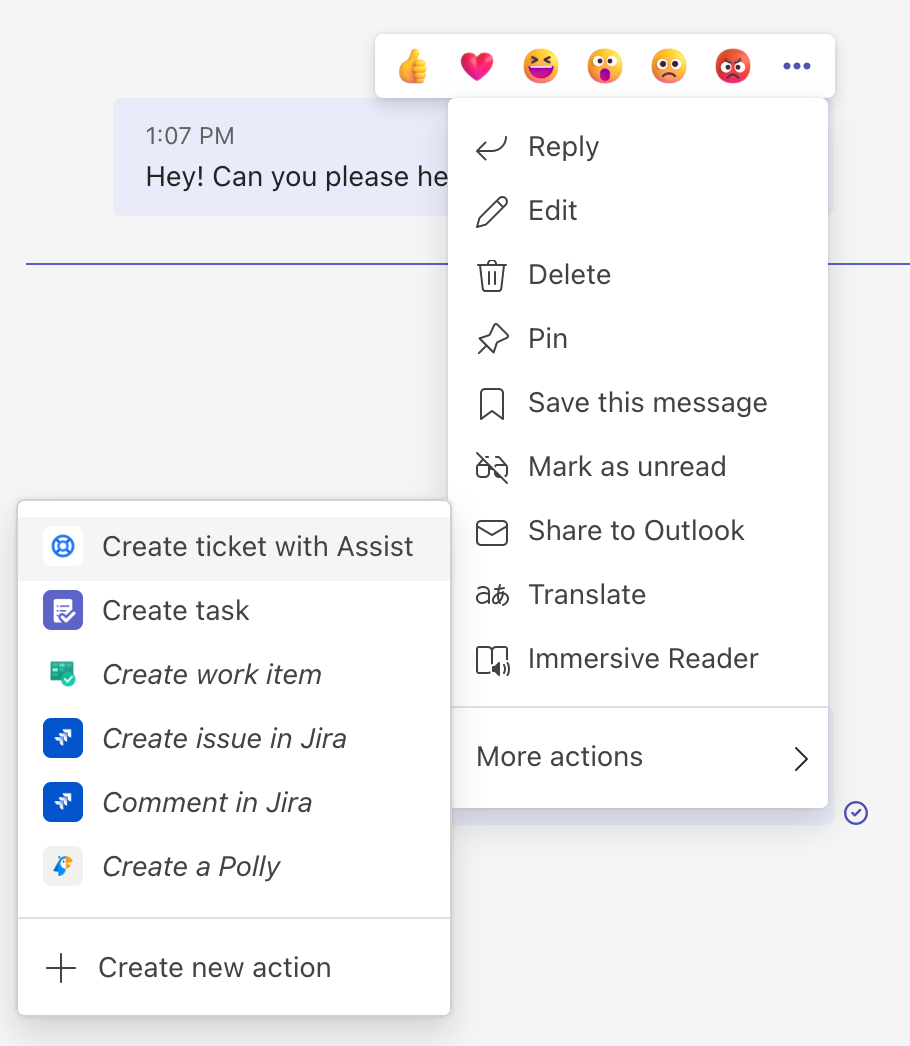
From the Assist app
Visit the Assist App Home (Slack) and select Raise a request or click the life preserver logo in the message composer box (Teams).
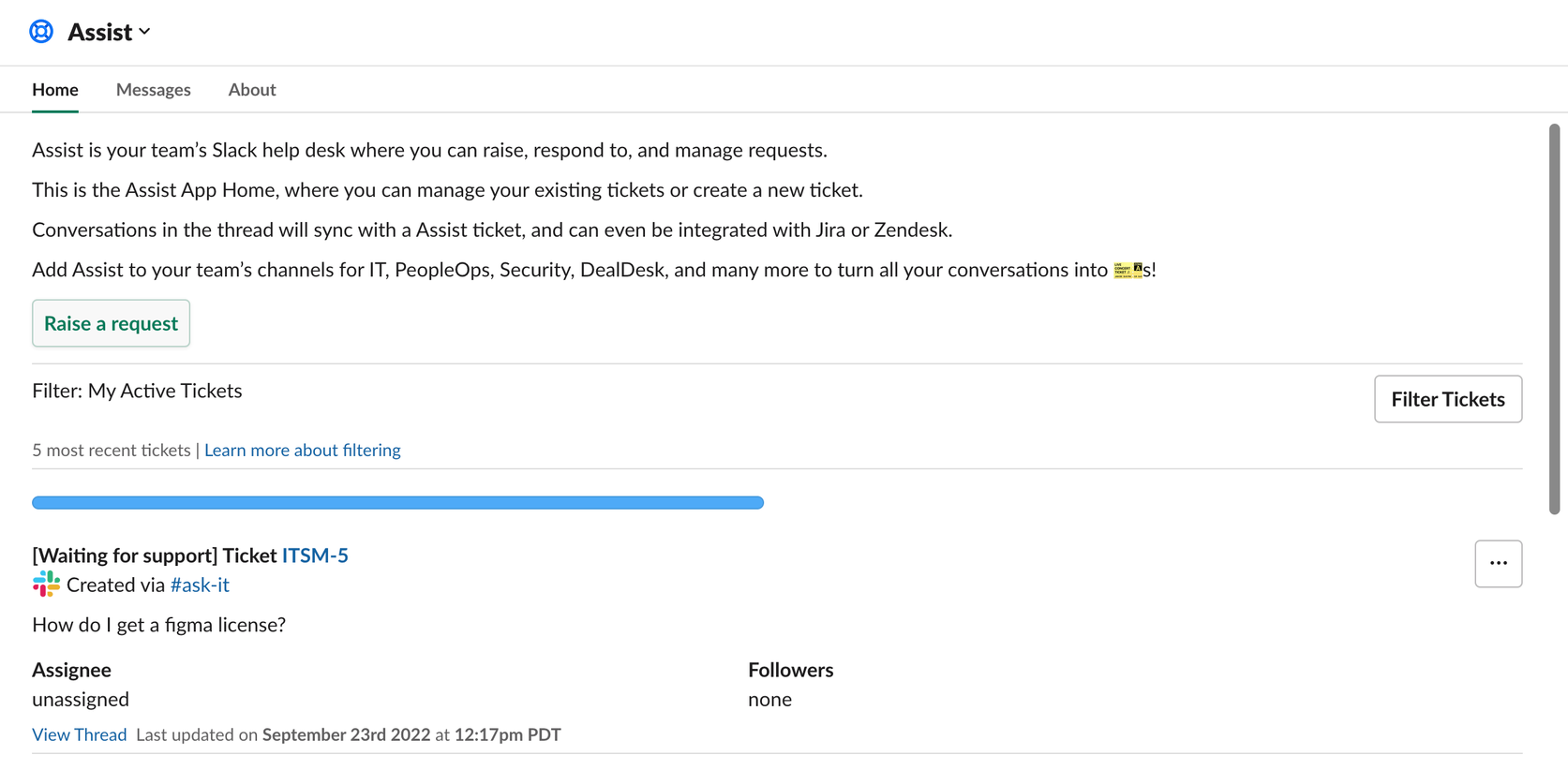

When we say you can work issues from end to end in Slack or Teams, we mean it. Chat allows you to add comments, make internal notes, assign yourself issues, transition statuses, review complete issue details, and more, all without ever leaving your chat tool.
Customize your chat settings
Supercharge your conversational service desk with a few of our favorite advanced features.
Approvals
Simplify approvals for Jira Service Management issues by sending the approver a DM in Slack or Microsoft Teams via Assist. Rather than having to navigate to Jira Service Management, approvers can deny or approve the request directly from their conversations. Once you approve or decline a request, the message displays a timestamped notification recording your decision.
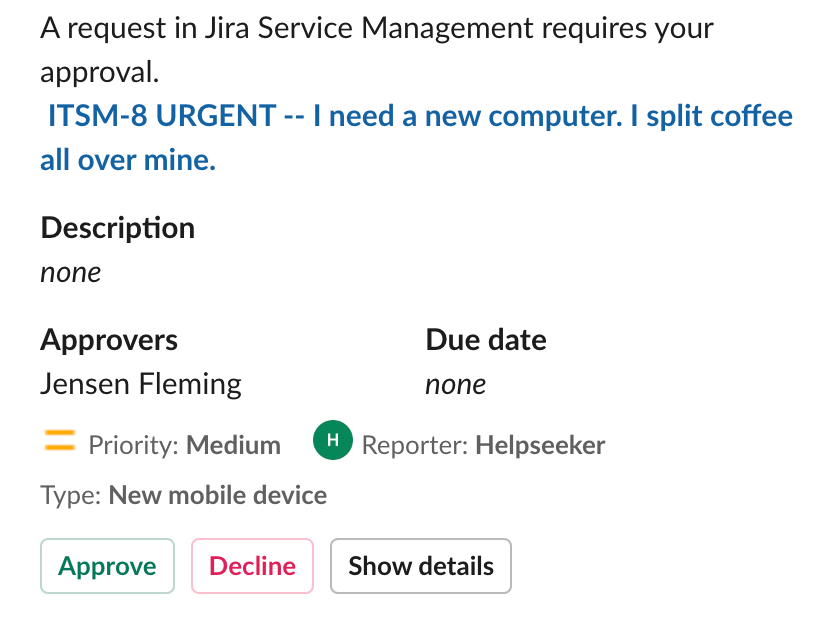
EmojiOps Slack only
Taking advantage of Jira automation’s powerful no-code shortcuts, chat offers the ability to speed up your workflows with emoji.
Start simple by using the eyes emoji (👀) to assign issues or the checkmark (✅) to close a request. Trigger the full suite of Jira automation with one simple emoji!
Private chat request Slack only
Manage sensitive requests with privacy in mind. Perfect for teams like HR, finance, and legal, this setting sends all request updates via private direct message instead of posting publicly in a channel.
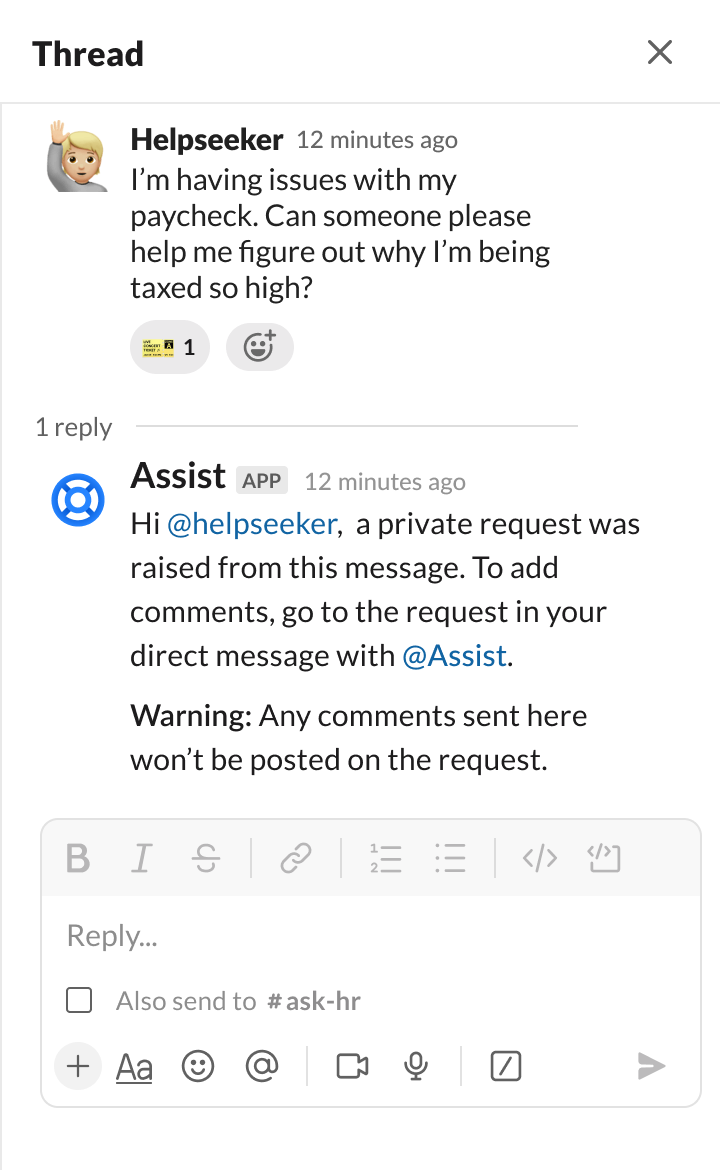
Tip: All issues created in Microsoft Teams are automatically private, so no need to change anything in settings.
Automatic issue creation Slack only
One of the biggest ways chat helps you save time is through automatic issue creation. When turned on, Assist turns any message in a request channel into a trackable issue in your project — removing an extra step for agents or requesters.
If the request type has any required fields, the requester receives a prompt to fill them out. If there are no required fields, the message turns into an issue as soon as it's posted. Assist reacts with a lightning emoji to indicate automatic issue creation.
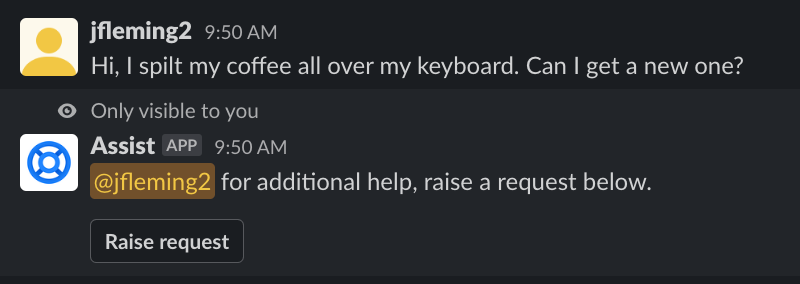
Form required

No form required
Chat for Operations (ChatOps) 101
WHAT IS Chat for Operations (ChatOps)?
Chat for Operations (ChatOps) brings Jira Service Management’s real-time alerting, on-call, and incident management to your collaboration platforms like Slack, Microsoft Teams, and Zoom to facilitate software development and IT operations tasks. Bring everyone into one place so your responders don’t need to switch between multiple applications during their routine on-call shifts.

WHY DO YOU NEED IT?
When outages occur, every second counts, and the use of collaborative tools for communication has created a growing demand for teams to stay updated on critical notifications and tasks.
Integrating alert and incident workflows into platforms like Slack, Microsoft Teams, and Zoom allows agile Dev and IT Operations teams to stay aligned and react swiftly. Jira Service Management ChatOps App eliminates the need to switch between tools by bringing alerts and incidents directly to the team's workspace for seamless collaboration.
Why will you love it?
It centralizes all communication about Jira Service Management alerts, incidents, incident reports, plans, and progress, keeping everyone up to speed in real-time. And it provides a place for DevOps, IT, communications, security, legal, and other relevant teams to collaborate on not only incident resolution, but also future incident prevention and risk mitigation.
How can you try it in Jira Service Management?
By connecting your chat platforms with Jira Service Management ChatOps app, you can use Slack channels to work on alerts, create channels for your Jira Service Management incidents, add incident responders to your channels, update incident priorities, take incident actions, and help your team step in faster during incidents.
Connect your chat platforms to Jira Service Management’s ChatOps app today, in Slack, Microsoft Teams, or Zoom.
Getting started with ChatOps
Jira Service Management’s ChatOps app is built to reduce context switching and provide lightweight tasks like getting notified of new alerts and some heavy-weight tasks like collaboration with your team to resolve incidents.
Before you get started, let's look at the two critical features of the ChatOps app:
ALERTING AND ON-CALL
Jira Service Management’s ChatOps App notifies your team of alerts and lets them take actions, directly on the connected chat platform.
Along with getting the alert summary, description, and other key details, responders get to update incident status, priority, assign, snooze, add notes, and more.
All updates are synced with Jira Service Management, making sure no context or update is lost between Jira and your chat application.
Apart from button actions, ChatOps also provides 25+ commands to help responders take specific actions directly from the chat channel.
ChatOps gives you maximum control over which alerts and activities notify your team’s chat channel, and what alert details/actions are included in the notification.
INCIDENT MANAGEMENT
Jira Service Management’s ChatOps App allows a responder to create a war room (chat and meeting) in your collaboration apps, directly from the incident in Jira Service Management.
Important incident information is posted to the war room for all the incident responders. So, everyone who needs to work together to resolve the incident becomes part of the channel or meeting and gets a summary of the incident to catch up and jump right in.
Responders can directly manage incidents in the channel using action buttons. Supported actions include updating priority and status, adding stakeholders, sending stakeholders updates, adding messages as comments, and adding affected services.
Quick start guide with ChatOps
First off, you’ll need to connect your Jira Service Management site to your chat or video tool from Settings → Products → Chat and video tools. Only a Jira admin can do this, so if you’re not one, contact your Jira admin to get started.
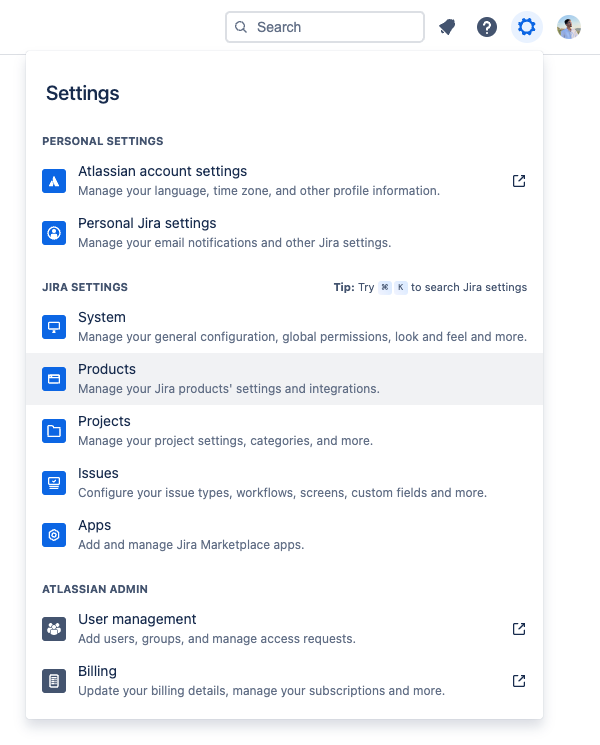
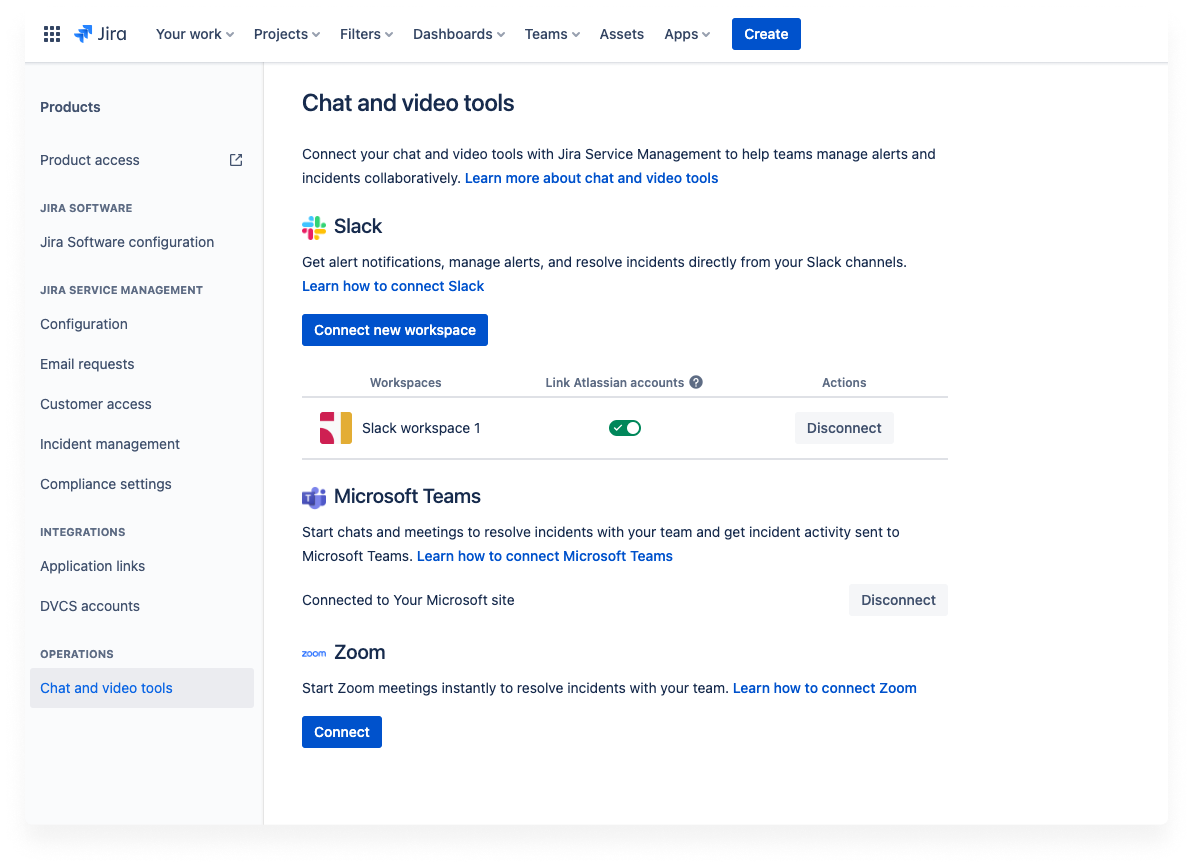
- Under Slack, select Connect new workspace
- Log in to Slack, and select Authorize to allow Jira Service Management to access your slack workspace.
Need more help? Read how to connect Slack
- Once you sign in to your Microsoft account, you’ll be redirected to Jira Service Management where you’ll see that the Microsoft Teams Administrator’s permission is required for Jira Service Management to create chats and meetings in Microsoft Teams.
- If you’re the Teams Administrator, select Give permission.
- If you’re not the Teams Administrator, select Copy link and share it with your Teams Administrator so they can authorize you to give permission to Jira Service Management. Once you’re authorized, select Give permission to continue. Learn more about permissions required by Atlassian ChatOps.
Need more help? Read how to connect Microsoft Teams
- Under Zoom, select Connect. You can only connect one Zoom account to your site. Similarly, you can only connect only one site to your Zoom account.
- You will now be prompted to select click Allow on the next screen. This will allow Zoom to access your Atlassian profile information and will let agents create Zoom meetings in Jira Service Management.
Need more help? Read how to connect Zoom
Helpful reminders
- A Jira site can connect to multiple Slack workspaces or Microsoft Teams, but a Slack workspace or Microsoft tenant can only connect to one Jira site.
- A Jira site can connect to only one Zoom account, and vice versa (a Zoom account can’t connect to multiple Jira sites).
Creating chats and meetings for incidents
Any agent in the Jira Service Management project can create a chat and meeting for incidents.
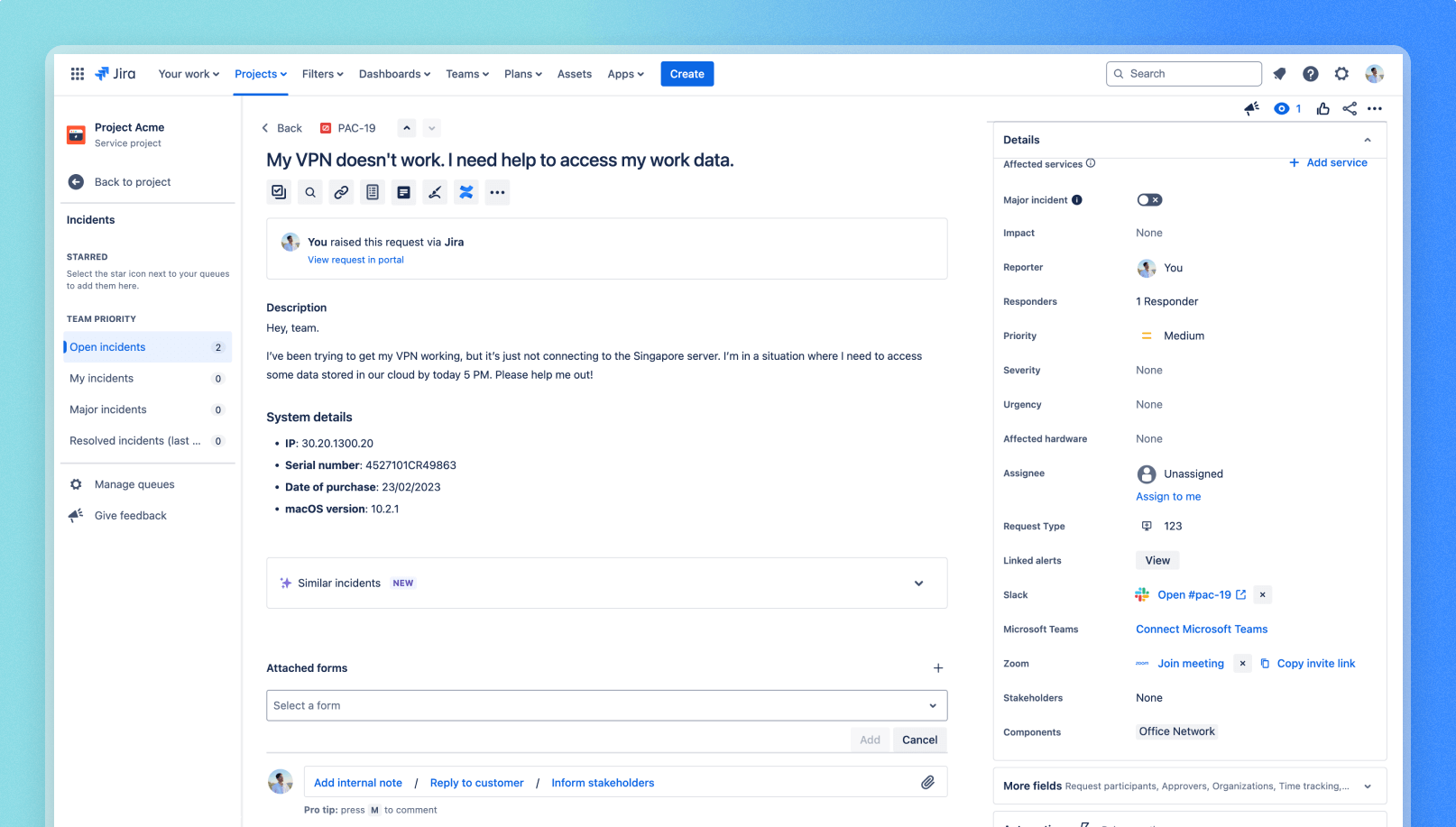
To create a chat or meeting:
- In your service project, go to Incidents and open the incident you’d like to create the chat channel for.
- In the Details section, find the Slack, Microsoft Teams, and Zoom fields.
- Create a chat or meeting with your chat tools.
- You’ll be prompted to customize any prefilled details of the channel or meeting before you create it.
Once created, your chat or meeting will be linked to the incident’s details section.
Automate creating Slack channels for incidents SLACK ONLY
Don’t want your team to waste time creating channels manually each and every time? Of course, there’s a way for you to automate it!
With Jira automation’s Create Slack channel for incident action, you can automate creating a Slack channel for incidents and adding incident responders to it, based on the conditions you specify in the rule. You even get to customize the name, description, and members of the channel. Read how to automate creating Slack channels
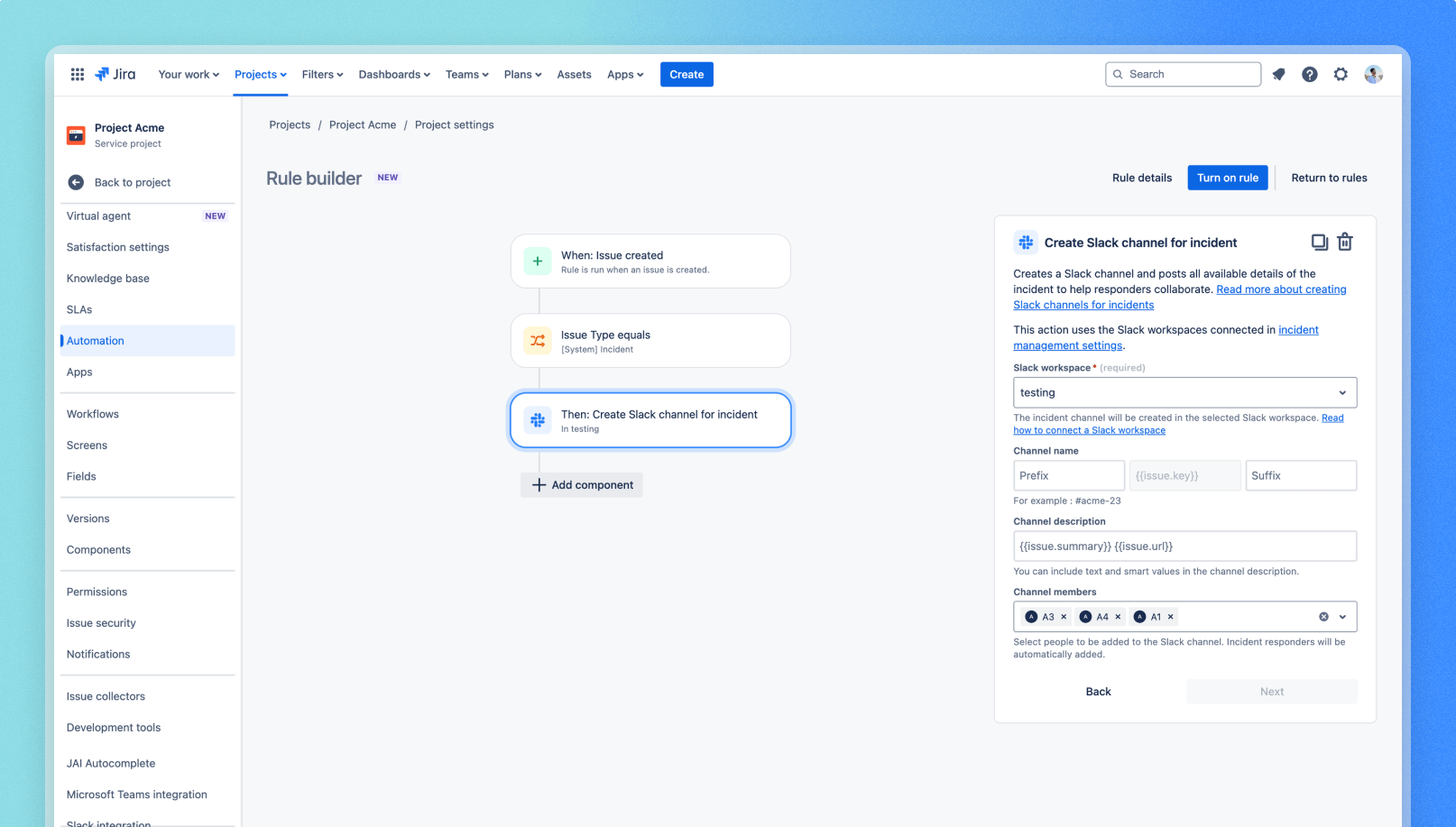
Manage incidents from chats
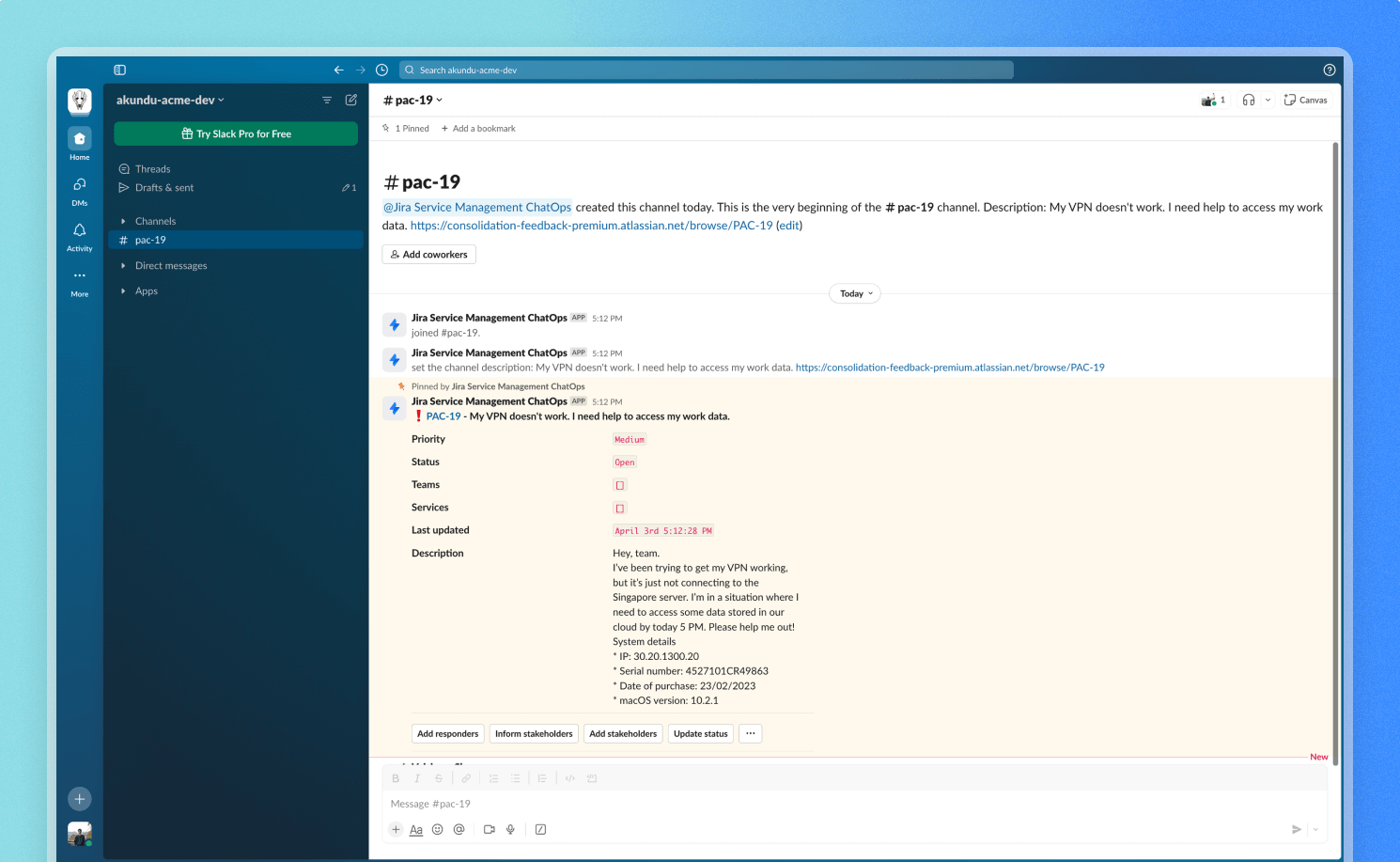
As soon as the channel is created, you'll receive a summary of the incident from which you can:
- add responders, stakeholders, and affected services,
- assign the incident to someone
- send stakeholder updates
- update the status and priority.
- add chat messages as comments to the incident, as an internal note or as a reply to the customer. You can do this from More options of a chat message.
Sync Zoom meeting recordings to the incident
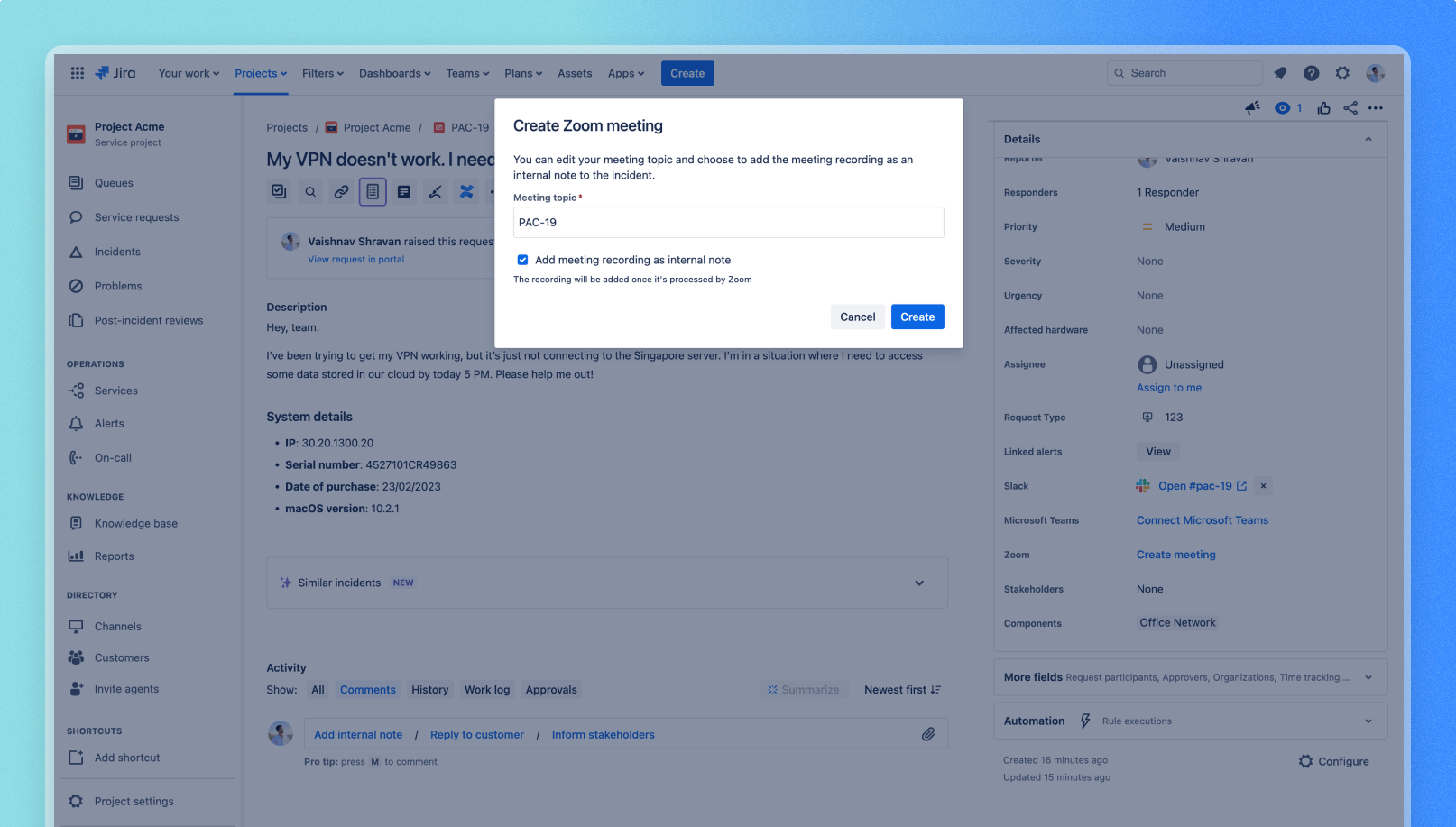
When you start a Zoom meeting for an incident, you don’t just bring your team together to resolve the incident, you also have the option to get the whole meeting recording posted on the incident’s comment, for reference later.
Get notified of Zoom meetings on Slack SLACK ONLY
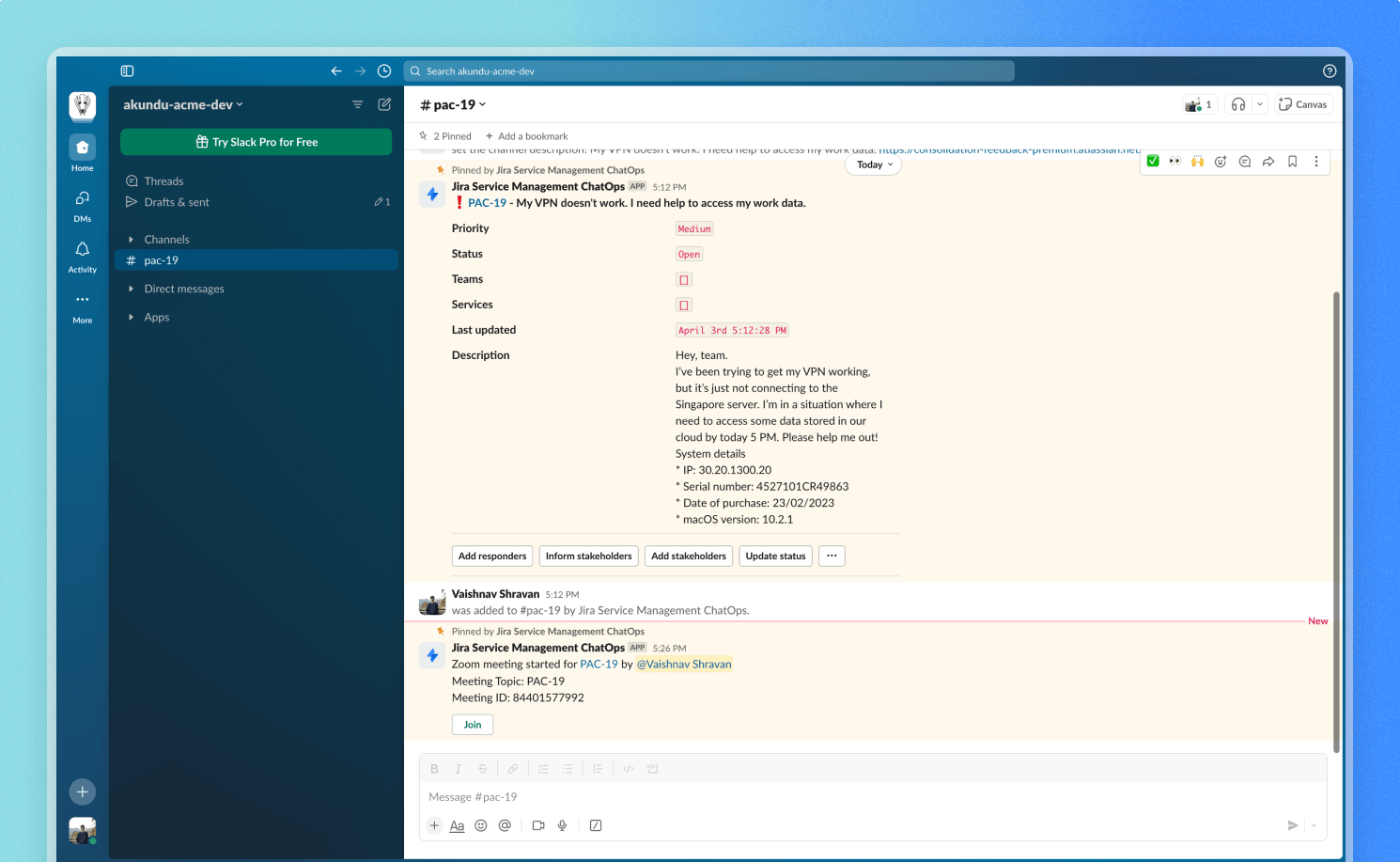
When you have Jira Service Management connected with Zoom and Slack, you’ll unlock perks such as getting notifications whenever a new meeting starts for an incident, directly in the Slack channel.
This keeps your team in the loop and saves you all the time you’d otherwise spend inviting everybody who’s required.
Respond to alerts using ChatOps
With Jira Service Management’s ChatOps app for Slack and Microsoft Teams, you can receive notifications for the alerts you care about, perform actions on the alerts, and manage some on-call work from your chats — using buttons and commands.
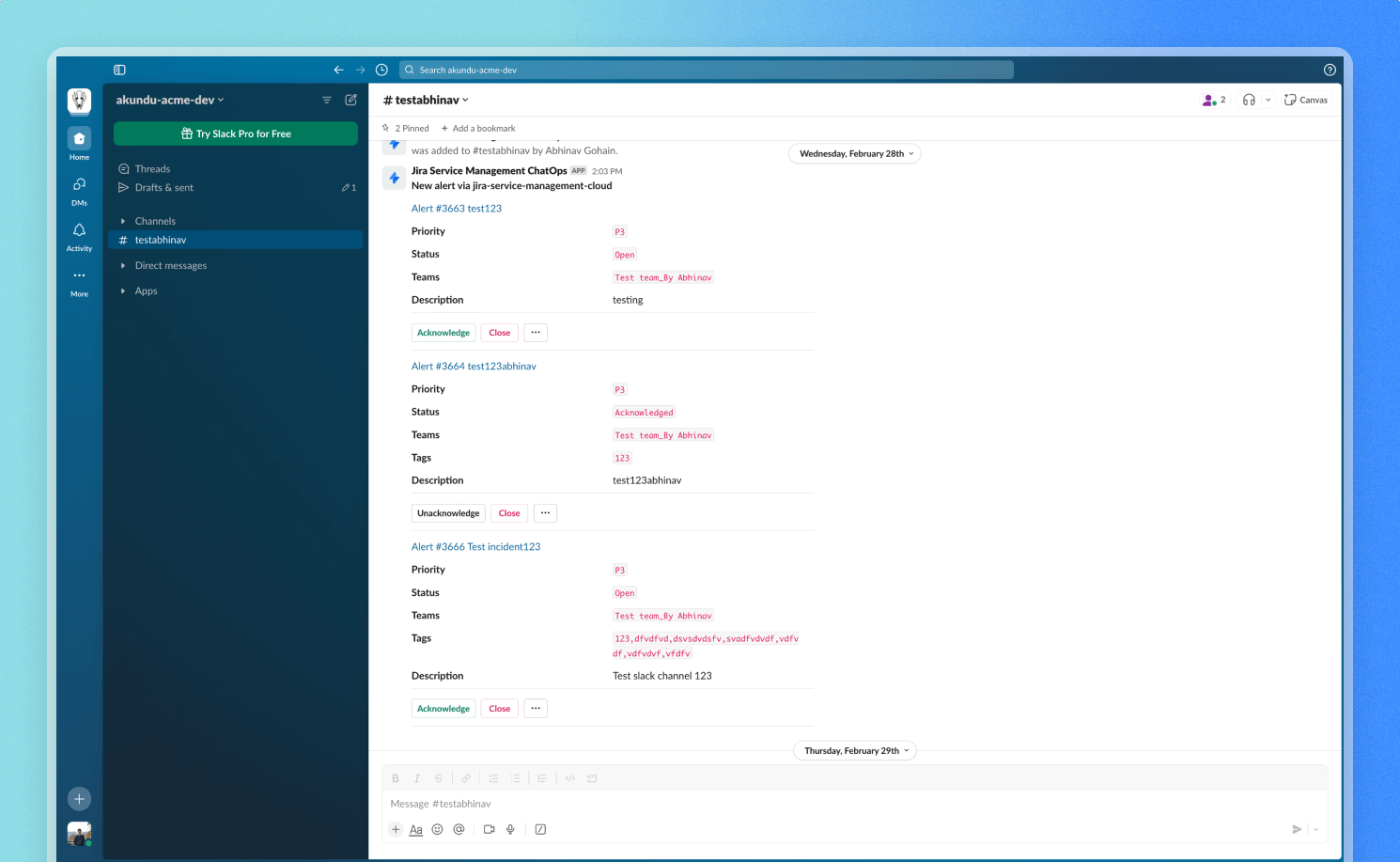
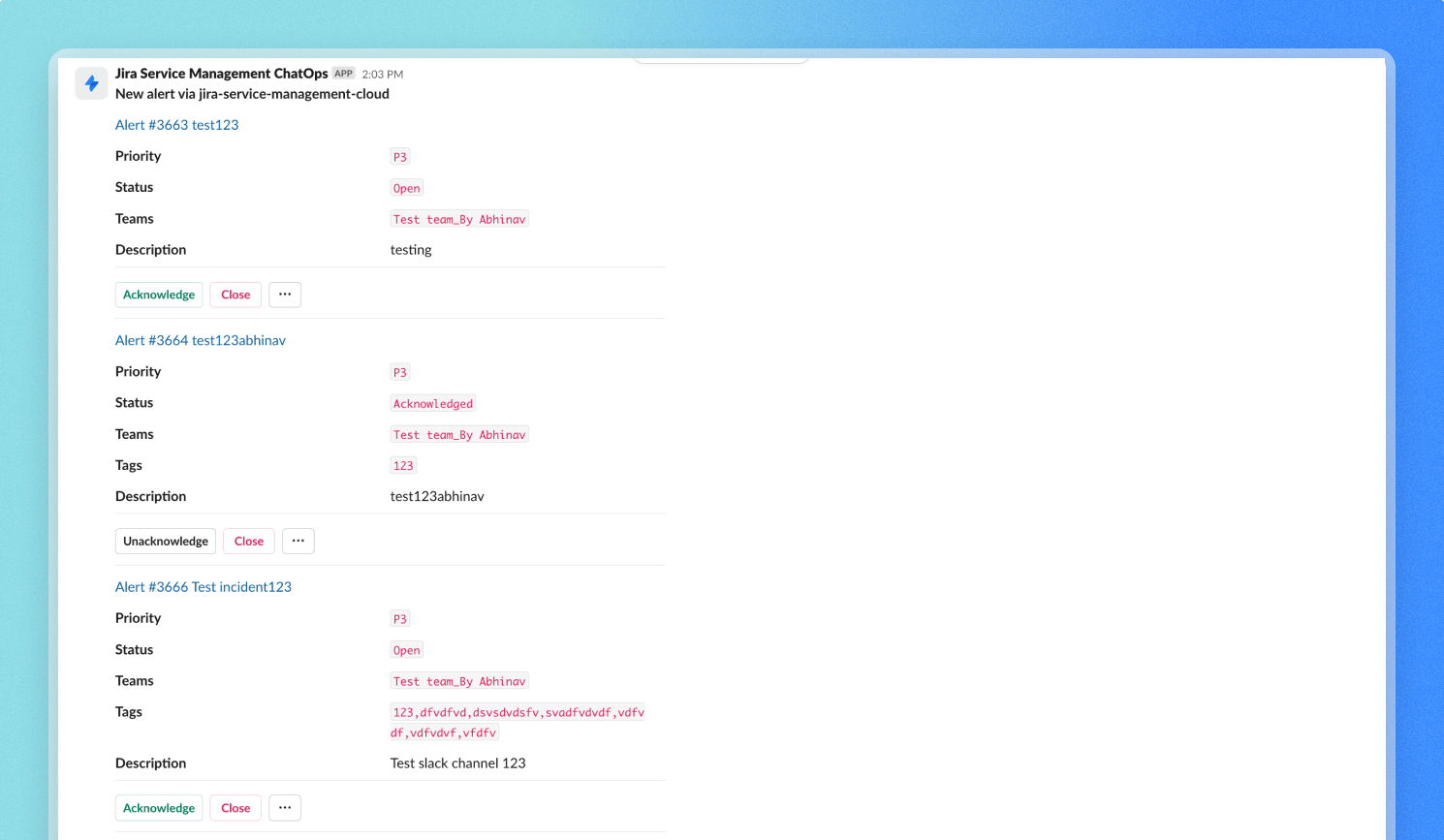
Add an alerting integration
Jira admins can see add integrations for the Jira Service Management site from Settings → Products → Integrations, while team admins can add them from the team profile page’s Operations section → select Go to operations → select Integrations from the sidebar → select Add integration.
From the list of integrations, select Slack or Microsoft Teams.

SLACK
Fill in some important details for your integration.
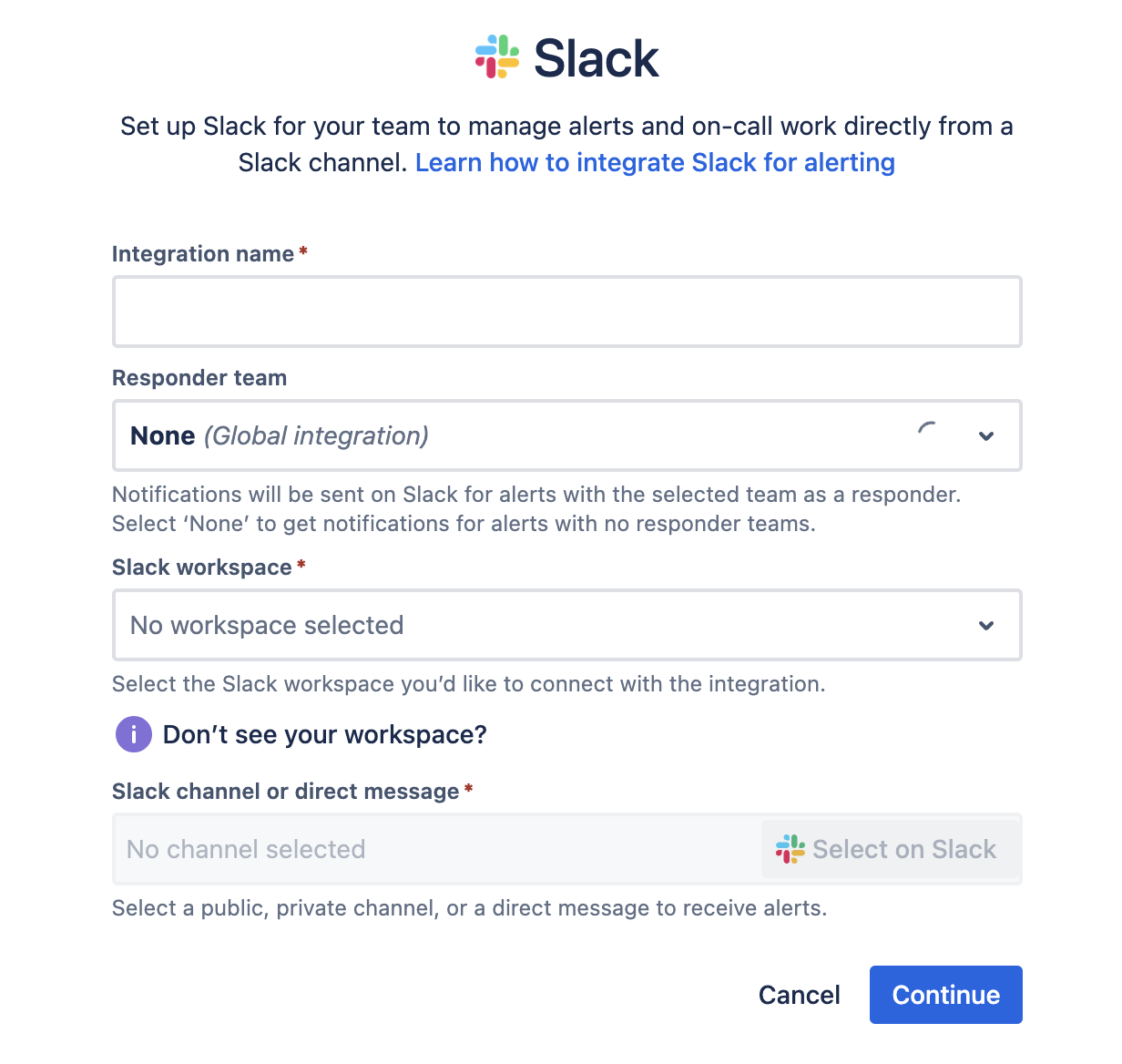
- Integration name: Name your integration to easily find it later.
- Responder team: The integration will send alerts for which the team you select is a responder.
- Slack workspace: Select the Slack workspace where your channels exist. If you don’t see your workspace, make sure you have joined the connected workspace, then, send /connect on any Slack channel or direct message.
- Slack channel or direct message: On selecting Select on Slack, you’ll be able to select a channel or direct message to receive alert notifications from this integration. Select Allow to confirm your choice and give Jira Service Management requested permissions on Slack.
- Select Continue to save the integration. It will be ON by default.
Need help? Read how to integrate with Slack
MICROSOFT TEAMS
Fill in some important details for your integration.
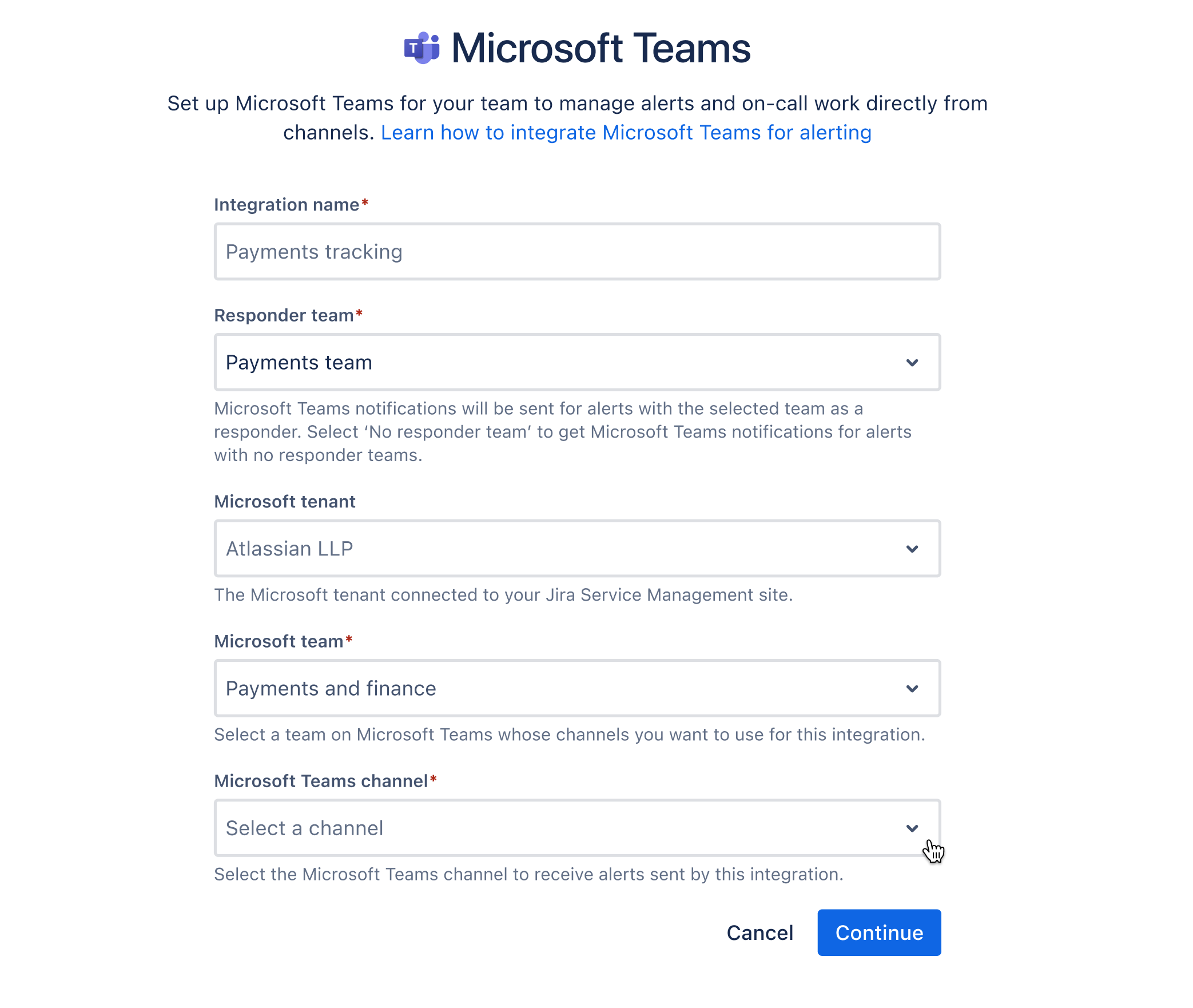
- Integration name: Name your integration to easily find it later.
- Responder team: The integration will send alerts for which the team you select is a responder. You can select ‘None’ to get notifications for alerts with no responder teams.
- Microsoft tenant: Select the Microsoft tenant where your channels exist.
- Microsoft team: Select your team on Microsoft Teams whose channels you’d like to use for this integration.
- Microsoft Teams channel: Select the channel to receive alert notifications from this integration.
- Select Continue to save the integration. It will be ON by default.
Giving permission to Jira Service Management
The Atlassian ChatOps app will need permission to post alerts to your channels in Microsoft Teams. Select Give permission to complete this step, if requested, and continue to setting up your integration.
Need help? Read how to integrate with Microsoft Teams
You can configure your integration as per your preferences:
- Edit integration settings to choose if alert actions show as buttons and to include additional alert fields in the incident summary sent to your chat channel.
- Add filters to receive only certain alerts. No filters are added by default.
- Select the alert activity to get notified of on your chat channel. All alert activity is selected by default.
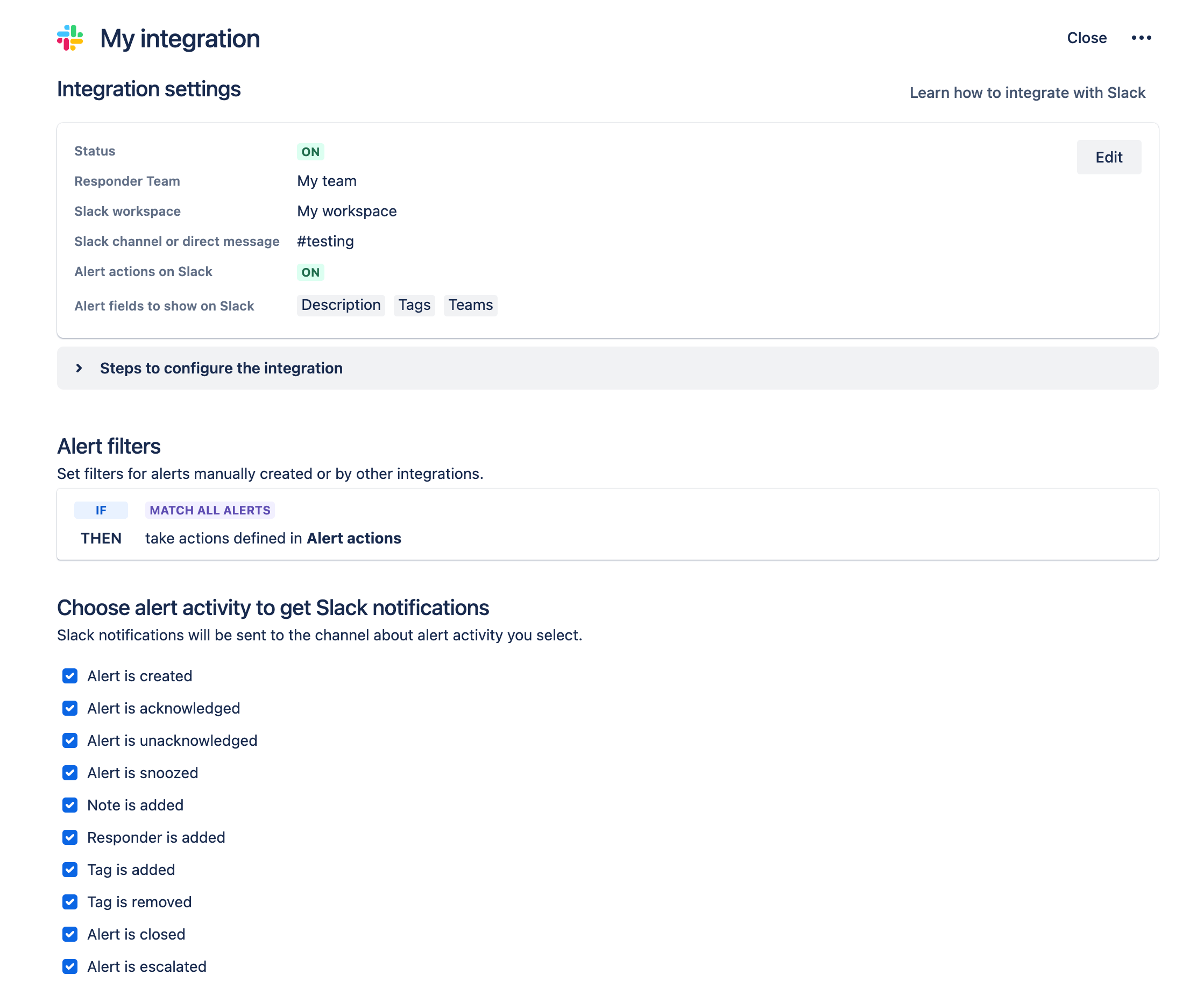
You can add multiple integrations to streamline alert notifications. For example, you can create an integration that notifies a chat channel only about high-priority alerts, and another integration that notifies a different chat channel about low-priority alerts.
Respond to alerts using buttons and commands
BUTTONS
Use buttons to take common actions quickly on the alert in chat, without having to open it on Jira Service Management.
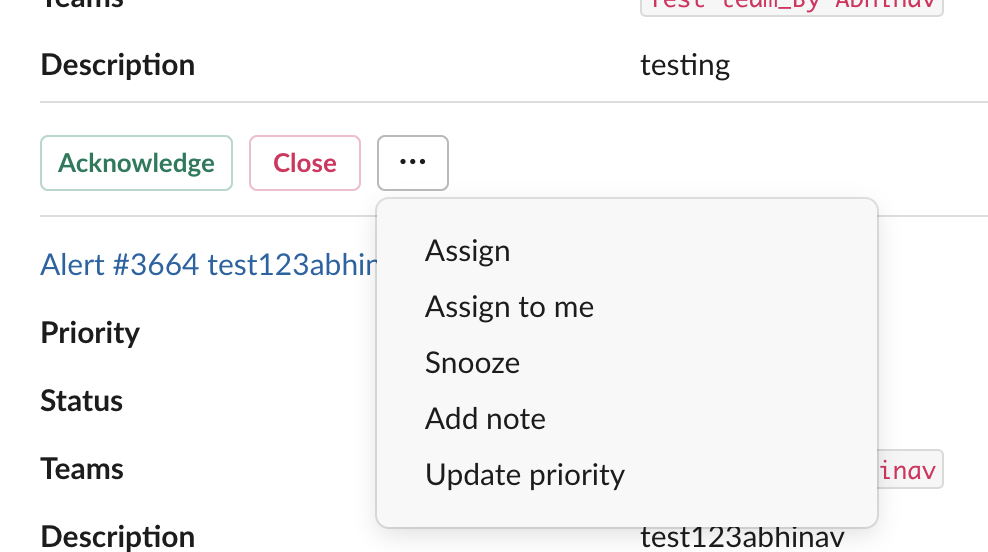
Supported actions include Acknowledge, Close, Assign, Snooze, and Update priority.
COMMANDS
Use commands to perform a lot more actions that aren’t supported via buttons.

View all commands for Slack and Microsoft Teams
Tips and tricks
AI Feature Guide
Tips and tricks
Virtual Agent Feature Guide
Tips and tricks
Agent onboarding